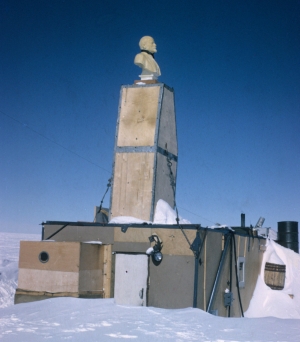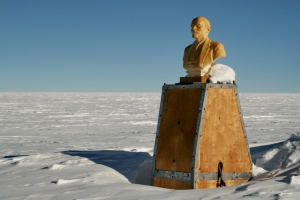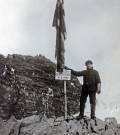The Pole of InaccessibilityIt has been a brisk day with gales and -30°C. The snow gets rough when it drifts and our skis meet much more resistance. We have also been obliged to keep a close watch on our faces and hands today because of the strong wind.
“We have been lucky, as usual. The wind backed – after having blown at storm force from the SE – to N. and eased and cleared up. We lost no time in turning out and setting off. We first had to cross the Devil's ballroom. Shiny bare ice with snow-filled crevasses here and there. ”– Amundsen on this day 100 years ago (Read more …) 
One of our favorite articles of clothing is the “nose mitten” made especially for us by Glen Liston from Colorado. It stays on our noses from morning till night and protects against sun and cold. We are heading for the South Pole – a place many others will also visit. But another and perhaps even more exotic pole for those in search of adventure is the Pole of Inaccessibility. When the Americans built the Amundsen–Scott Station at the geographical South Pole in November 1956, they had occupied the most prominent place in Antarctica. The Soviet Union responded by building a station at the Pole of Inaccessibility in December 1958. This place is as far from the ocean as it is possible to get, and can therefore be viewed as the most inaccessible place in Antarctica. The two superpowers had shown off their muscles by establishing themselves each at their separate poles. First the Russians flew reconnaissance missions (on an IL-12) during the third Soviet Antarctic Expedition in December 1957, as a part of the International Geophysical Year. The same month, they mounted an expedition from the coastal station Mirny. The expedition consisted of ten tractors and 32 men, a formidable convoy, in other words. But they didn’t make it to the Pole of Inaccessibility that year. A small party of four were left behind to spend the winter at the stopping point – undoubtedly a spartan overwintering, unplanned as it was. 
Then, 14 December 1958, a team of 17 men finally reached the Pole of Inaccessibility after a 2100-kilometre traverse that had set out from Mirny as early as in September. Naturally, the arrival at their goal was celebrated; among other things the Soviet flag was raised. A more original form of celebration was that these tough and hardy men also shot off fireworks. Two weeks later the expedition turned homeward after having erected a small research station. Today the only part that remains visible is the bust of Lenin, which had been placed on the roof of the station. In January 2008, when the Norwegian–American research expedition visited the Pole of Inaccessibility, they were the seventh group ever to visit the site. But as the geographic South Pole becomes more “public domain” we suspect Lenin may start to see more and more visitors. Position: S 86 17.271, W 175 17.993
Temperature: -30°C Wind: 10–12 m/s from the southeast Elevation: 2800 metres Distance traversed: 24 km Distance behind Amundsen: 101 km Total distance traversed: 896 km Distance remaining to the South Pole: 415 km Did you know that Peter I Øy was once a fiery volcano?
But like of the rest of Antarctica, Peter I Øy (Peter I Island) has long been covered in snow and ice. |
South Pole 1911–2011 is an informational outreach project run by the Norwegian Polar Institute
Contact person:


